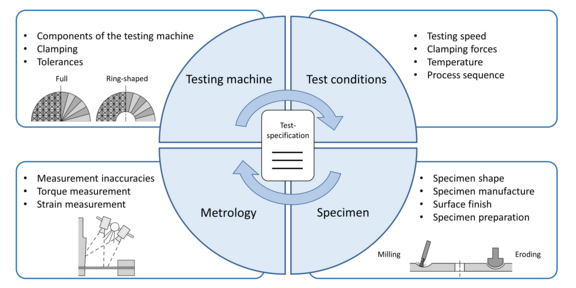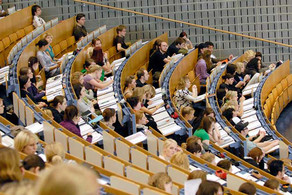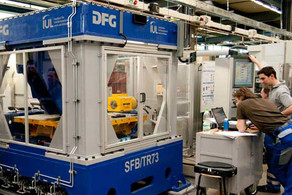Projects
Basic research on forming technology
Preparing the Standardization of the In-Plane Torsion Test
- Profil- und Blechumformung
- Mechanik
- Materialcharakterisierung
- Industrienahe Forschung

| Funding | AiF/FOSTA |
| Project | 21137N/P 1320 |
| Contact | Fabian Stiebert M. Sc. |
| Status | Completed |
The aim of this project was to analyze the fundamental influencing variables of the in plane torsion test and to use the results to prepare a test specification. For this purpose, the influencing variables were divided into four main areas. First, the influence of the testing machine was investigated, identifying the required machine components and the shape of the clamping for a homogeneous torque transmission. Furthermore, the test conditions were analyzed by considering the required clamping forces and a quasi-static test condition. Here, an analytical approach could be derived and verified, which can calculate the maximum strain rate depending on the material behavior, a radius ratio and the rotational speed. In the area of measurement technology, all influences of specimen, torque and strain measurements were considered. Furthermore, the influence of specimen shape and specimen fabrication on the test results was investigated. An adapted specimen shape, which produces a homogeneous stress and strain distribution over a wide test range, was proposed for the test specification. Finally, a proposal for a test specification was developed.
The results of the project will soon be available in the form of a final report from the Forschungsvereinigung Stahlanwendung e. V. (FOSTA).
[Translate to English:]
![[Translate to English:] [Translate to English:]](/storages/iul-mb/_processed_/7/7/csm_AiF_Logo_CMYK_bc192ba96e.jpg)
Contact
Material characterization
Preparing the Standardization of the In-Plane Torsion Test
- Profil- und Blechumformung
- Mechanik
- Materialcharakterisierung
- Industrienahe Forschung

| Funding | AiF/FOSTA |
| Project | 21137N/P 1320 |
| Contact | Fabian Stiebert M. Sc. |
| Status | Completed |
The aim of this project was to analyze the fundamental influencing variables of the in plane torsion test and to use the results to prepare a test specification. For this purpose, the influencing variables were divided into four main areas. First, the influence of the testing machine was investigated, identifying the required machine components and the shape of the clamping for a homogeneous torque transmission. Furthermore, the test conditions were analyzed by considering the required clamping forces and a quasi-static test condition. Here, an analytical approach could be derived and verified, which can calculate the maximum strain rate depending on the material behavior, a radius ratio and the rotational speed. In the area of measurement technology, all influences of specimen, torque and strain measurements were considered. Furthermore, the influence of specimen shape and specimen fabrication on the test results was investigated. An adapted specimen shape, which produces a homogeneous stress and strain distribution over a wide test range, was proposed for the test specification. Finally, a proposal for a test specification was developed.
The results of the project will soon be available in the form of a final report from the Forschungsvereinigung Stahlanwendung e. V. (FOSTA).
[Translate to English:]
![[Translate to English:] [Translate to English:]](/storages/iul-mb/_processed_/7/7/csm_AiF_Logo_CMYK_bc192ba96e.jpg)
Contact
Technology development
Preparing the Standardization of the In-Plane Torsion Test
- Profil- und Blechumformung
- Mechanik
- Materialcharakterisierung
- Industrienahe Forschung

| Funding | AiF/FOSTA |
| Project | 21137N/P 1320 |
| Contact | Fabian Stiebert M. Sc. |
| Status | Completed |
The aim of this project was to analyze the fundamental influencing variables of the in plane torsion test and to use the results to prepare a test specification. For this purpose, the influencing variables were divided into four main areas. First, the influence of the testing machine was investigated, identifying the required machine components and the shape of the clamping for a homogeneous torque transmission. Furthermore, the test conditions were analyzed by considering the required clamping forces and a quasi-static test condition. Here, an analytical approach could be derived and verified, which can calculate the maximum strain rate depending on the material behavior, a radius ratio and the rotational speed. In the area of measurement technology, all influences of specimen, torque and strain measurements were considered. Furthermore, the influence of specimen shape and specimen fabrication on the test results was investigated. An adapted specimen shape, which produces a homogeneous stress and strain distribution over a wide test range, was proposed for the test specification. Finally, a proposal for a test specification was developed.
The results of the project will soon be available in the form of a final report from the Forschungsvereinigung Stahlanwendung e. V. (FOSTA).
[Translate to English:]
![[Translate to English:] [Translate to English:]](/storages/iul-mb/_processed_/7/7/csm_AiF_Logo_CMYK_bc192ba96e.jpg)
Contact
Industry-related research
Preparing the Standardization of the In-Plane Torsion Test
- Profil- und Blechumformung
- Mechanik
- Materialcharakterisierung
- Industrienahe Forschung

| Funding | AiF/FOSTA |
| Project | 21137N/P 1320 |
| Contact | Fabian Stiebert M. Sc. |
| Status | Completed |
The aim of this project was to analyze the fundamental influencing variables of the in plane torsion test and to use the results to prepare a test specification. For this purpose, the influencing variables were divided into four main areas. First, the influence of the testing machine was investigated, identifying the required machine components and the shape of the clamping for a homogeneous torque transmission. Furthermore, the test conditions were analyzed by considering the required clamping forces and a quasi-static test condition. Here, an analytical approach could be derived and verified, which can calculate the maximum strain rate depending on the material behavior, a radius ratio and the rotational speed. In the area of measurement technology, all influences of specimen, torque and strain measurements were considered. Furthermore, the influence of specimen shape and specimen fabrication on the test results was investigated. An adapted specimen shape, which produces a homogeneous stress and strain distribution over a wide test range, was proposed for the test specification. Finally, a proposal for a test specification was developed.
The results of the project will soon be available in the form of a final report from the Forschungsvereinigung Stahlanwendung e. V. (FOSTA).
[Translate to English:]
![[Translate to English:] [Translate to English:]](/storages/iul-mb/_processed_/7/7/csm_AiF_Logo_CMYK_bc192ba96e.jpg)
Contact
Completed Projects
Preparing the Standardization of the In-Plane Torsion Test
- Profil- und Blechumformung
- Mechanik
- Materialcharakterisierung
- Industrienahe Forschung

| Funding | AiF/FOSTA |
| Project | 21137N/P 1320 |
| Contact | Fabian Stiebert M. Sc. |
| Status | Completed |
The aim of this project was to analyze the fundamental influencing variables of the in plane torsion test and to use the results to prepare a test specification. For this purpose, the influencing variables were divided into four main areas. First, the influence of the testing machine was investigated, identifying the required machine components and the shape of the clamping for a homogeneous torque transmission. Furthermore, the test conditions were analyzed by considering the required clamping forces and a quasi-static test condition. Here, an analytical approach could be derived and verified, which can calculate the maximum strain rate depending on the material behavior, a radius ratio and the rotational speed. In the area of measurement technology, all influences of specimen, torque and strain measurements were considered. Furthermore, the influence of specimen shape and specimen fabrication on the test results was investigated. An adapted specimen shape, which produces a homogeneous stress and strain distribution over a wide test range, was proposed for the test specification. Finally, a proposal for a test specification was developed.
The results of the project will soon be available in the form of a final report from the Forschungsvereinigung Stahlanwendung e. V. (FOSTA).
[Translate to English:]
![[Translate to English:] [Translate to English:]](/storages/iul-mb/_processed_/7/7/csm_AiF_Logo_CMYK_bc192ba96e.jpg)





![[Translate to English:] [Translate to English:]](/storages/iul-mb/_processed_/0/f/csm_Forschung1_2880x640_patrick_7b98a9cf47.png)